-Justin Emge
The numbers are in, and once again, Dick Clark’s New Year’s Rockin’ Eve came in first place with around 5.78 million viewers. Of course, this number doesn’t include the millions of other viewers around the world who watched the ball drop in Times Square from the special Times Square Alliance broadcast, but massive numbers in both cases!
What most don’t understand is the amount of work that goes into such a massive production. Unlike sporting events where there is an infrastructure already in place at said stadium, Times Square is an outside broadcast like no other which requires weeks of setup and months of planning. To put this in perspective, if you go to a major local sports facility, they have a dedicated parking spot for the TV truck(s), a terminal room that connects the truck to every corner of the facility, a broadcast box for the talent, proper power drops, the list goes on and on. Go to Times Square and none of this is built-in, and when you consider that the broadcast covers the entire “bow-tie” from West 43rd Street to 46th Street, what you have is a production of epic proportions

In other words, the Broadcast Engineers for the New Year’s Eve Ball Drop must build out a broadcast facility and distribute audio and video in an area that is almost double the size of any major stadium in the world.
Since there isn’t enough time (or knowledge) to dig into how the entire production is pulled off, I’m going to dig into a very specific portion that is integral to the broadcast… Wireless communications for the crews, and wireless mics and IFBs for the talent on ABC’s portion of the show.
JETWAVE WIRELESS
Before I dig into the specifics, I first want to introduce you to Jetwave Wireless. They are a locally-based company that specializes in RF and provide special services for events like the New Year’s Eve Ball Drop. You have probably never heard of them, but you have literally heard their work on some of the biggest shows, especially the larger productions that take place in New York or Washington, DC. For New Year’s Eve, the man in charge of wired and wireless comms was Josh Flower, while Ryan Stotts took care of the wireless mics and IFBs. Jetwave has been providing this service to ABC and the Times Square Alliance for the better part of 20 years and has continuously improved in order to provide the best quality to their customer.
WIRELESS MICS AND IFB FOR ABC
ABC’s coverage of the New Year’s Eve Ball Drop is by far the primary concern throughout Times Square. If you watch the broadcast, you will see two roaming crews that travel from ABC’s Time Square Studios, down to Duffy Square at 46th Street and up to the roof of 1540 Broadway, otherwise known as the Disney Roof (as the ever-popular Disney Store is just below.) When the crews move around, they not only need but EXPECT seamless coverage with no dropouts. Imagine the frustration if Mr. Seacrest’s mic and IFB dropped out during a live hit? To accomplish this, Jetwave Wireless has set up a massive RF over Fiber system that hits every corner of every block of the entire area. To get a transmitter or receiver deployed on each block, a network of fiber is hung weeks in advance. I would estimate that well over 15 miles of 12-pair fiber was hung or pulled up and down Broadway for the various crews to use. On every block, a rack of hardware was set up and connected back to Jetwave’s trailer on 45th Street where they were able to monitor and distribute RF. The microphone audio was then distributed to ABC’s OB truck, who in turn provided mix-minus back to Jetwave which was broadcasted out to the talent as they moved around Times Square. By all accounts, it worked phenomenally well and with no issues.
WIRELESS COMMUNICATIONS
Where things get a bit more difficult is on the communications side of things. In the same rack of the RF-over-fiber equipment was a Cisco SG-350, which was trunked back to a Cisco IE4010 in Jetwave’s trailer, which in turn was connected to the E-IPA card in the Eclipse Frame. This allowed Jetwave to distribute 24 IP Transceivers which provided coverage for 49 roaming FSII Beltpacks.
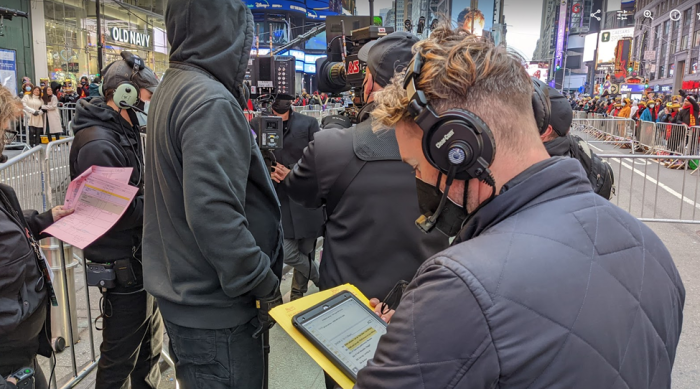
Roaming Crew for ABC's New Year's Rockin' Eve, each member using a FSII beltpack
The requirement was to allow each person wearing a FSII Beltpack from ABC’s Studio on 45th street to roam down to the main stage (Duffy Square) where the big-name artists played their numbers, then roam up to the roof of the Disney Store, and everywhere in between. To deploy so many transceivers, at least six Cisco switches were set up on Broadway, with ethernet drops to the various transceivers, all trunked back to the Clear-Com Eclipse frame in Jetwave’s trailer. But deploying this wasn’t as easy as throwing up the transceivers and walking away, you also had to get creative with the placement of those transceivers.
If you consider that Mr. Seacrest’s roaming crew had at least ten FSII beltpacks, and the stationary crews at ABC’s stage had another 15 to 20, capacity became a concern at the beginning and end of the show when everybody was congregating in the same exact area. Additional IP Transceivers were deployed in and around those high traffic areas in order to allow for 30 to 40 beltpacks.
To better illustrate the placement of the FSII IP Transceivers, here is a general idea of how the hardware was deployed.
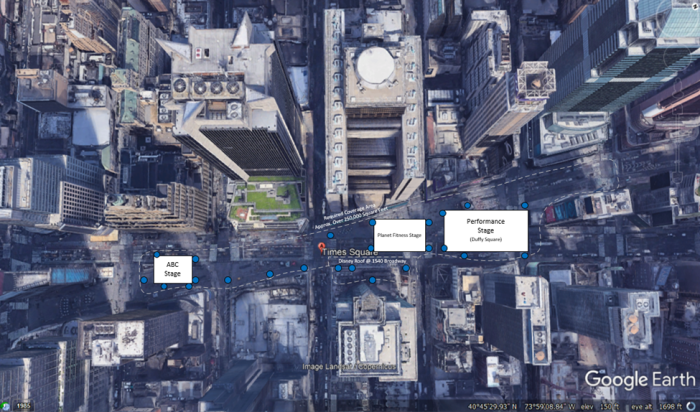
Blue dots represent FSII Transceiver placement
When it came to wired comms for the stationary positions, Jetwave took full advantage of the massive IP infrastructure and deployed HelixNet to the various positions. Each one was able to listen and talk on two different partylines while also enjoying the program audio feed from ABC’s truck.

Jib operator on the roof of Times Square Studios who also took advantage of Agent-IC when taking a break from the weather.
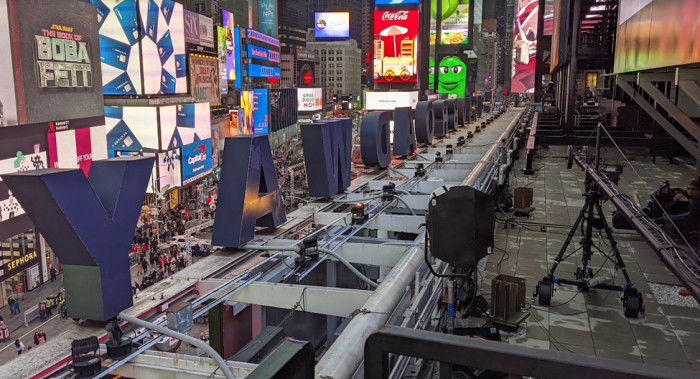
There were two stages and two jibs on the Disney Roof at 1540 Broadway
Where Jetwave got creative though was with their “cloud” service. Using the internet connection provided by the Times Square Alliance, Josh trunked over 20 audio paths back to an Eclipse frame that he had installed in a server farm in upstate New Jersey. With those trunks, he was able to deploy 32 Agent-IC connections to various members of the crew who needed to work remotely, or who needed to roam outside of the FSII coverage area in Times Square.
ARCADIA AND THE WORLD TRUCK
The final element that was especially exciting was the use of the Arcadia Central Station for the World Broadcast Truck, which was located next to 2 Times Square at Broadway and 47th Street. This truck was primarily used for two things, first was to provide a feed of Times Square to the webcast and to satellite for the international feed to other broadcasters in every country. They also did the live feed of the various acts that were on the Duffy Square Stage and the Planet Fitness stage, located between 47th and 45th streets. The acts were distributed to ABC’s truck for their broadcast.
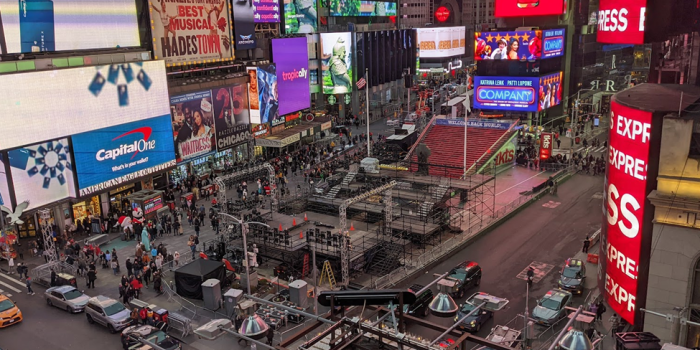
Duffy Stage with the World Truck in the background
Running the comms for that broadcast was Chris Debrizio, who deployed 7 IP Transceivers and 14 FSII Beltpacks.
IN CONCLUSION
If you ask any member of the crew that supports this broadcast, they will tell you flat out that the New Year’s Eve Ball Drop in Times Square is by far one of the most challenging events. Hundreds of people are needed not only for the setup, support and tear-down of the broadcast, but hundreds more are needed to set up the stages, the rigging, live sound, lighting, and all for a single six-hour event that must be torn out by 6 AM on January 1st. So yes, when I say that this is a broadcast of epic proportions, believe me……… It is MASSIVE.
Bravo to all involved, and Happy New Year! Here’s to hoping that the next Ball Drop in Times Square is another success!
Fun Fact: If you compared the length of AT&T Stadium in Dallas, TX, where there is a permanent infrastructure, to the length of Times Square, you might be surprised by the sheer size. According to Google Earth, AT&T Stadium measures out to be approximately 986 feet wide (much less if you consider just the field), while the entire broadcast area of Times Square is well over 1,200 feet long!
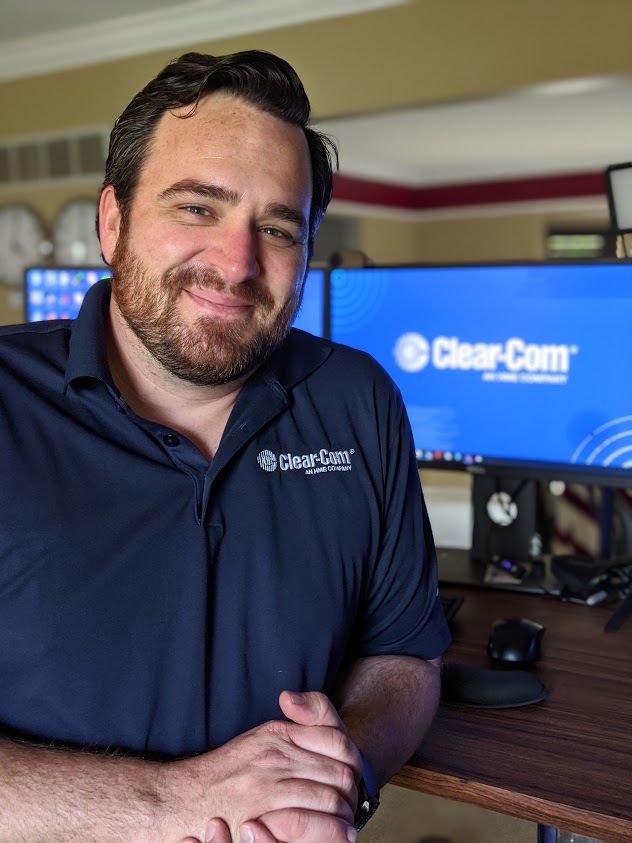 |
Justin Emge is the Applications Engineering Manager at Clear-Com. Previously, Justin was a Broadcast Engineer, Technical Director, News Photographer and Operations Manager for the CBS Affiliate in St. Louis, MO. He also worked laterally with Kaufman Broadcast as a Broadcast Engineer during large sporting and news events. Justin oversees the Application Engineers for North and South America. |